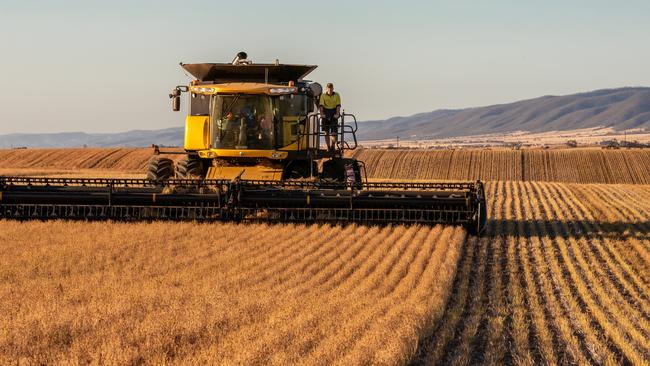Hay, grain talk: Lentil prices, hay export demand on the rise
Lentils are one of the few commodities offering growers a reprieve from a tough harvest this week, while the hay export market heats up.
GRAIN TALK:
Lentils are one of few commodities that are showing any signs of price gains for growers this
week.
Number one grade lentils are quoted at $785 a tonne delivered to Melbourne, a rise of $15
in a week. Since the start of the year, lentil prices have lifted 10 per cent, pleasing the many
growers who have stored their lentils on farm for cleaning and deferred marketing.
Price discovery and clarity on price movements in pulses can be tricky but this lift in lentil
prices may come from traders trying to wrench stocks from growers combined with support from a lower exchange rate.

The Aussie dollar fell just under 2 US cents last week. This is attributed to some poor global
economic news encouraging traders to snap up safe currencies like the US dollar as well as
some modest wage growth in Australia potentially trimming future interest rate rises.
Major weather scares are absent in key exporting countries, instead markets are more
focused on the flush of wheat that pours out of Russia and the lack of demand from China.
Russian wheat is dominating the Egyptian tenders and analysts point to the growing stocks
of wheat in eastern Europe. Fundamentals are pushing down prices but there are still risks.
Negotiations for the maintenance of the so called grain corridor in the Black Sea are to
continue this month. The conventional and defendable view in the trade is that Russia
wants to keep the corridor open as it has more to lose with it closed.
US wheat prices are once again trading at a substantial premium to European markets.
Accordingly, the US has further to fall in these markets and Chicago wheat futures fell
heavily, tumbling $31 a tonne or 7.5 per cent for the week.
Tightness of supplies in eastern Australia have restrained this global weakness. Trader’s bids
for wheat are down $5 a tonne and barley $7 but the ASX wheat futures and the delivered
are unchanged over the week.
The list of buyers bidding for grain held in the central handling systems is long and should
remain this way till the bulk of the grain for the heavily committed shipping program is
accumulated.
A lack of Chinese demand is holding back oilseed markets. Victorian canola bids are $25 a
tonne lower this week at $732 a tonne on a Geelong port basis.
HAY TALK:
Export demand has been determining the price of cereal hay with any redeeming features and it will remain a significant factor.
The impact of the export sector on the price of cereal hay has been much higher this season as the area baled was lower than normal. From this lower area, the volume of exportable quality of hay produced was further reduced by the relentless spring rains.
The three processing plants in NSW and the seven in Victoria have been picking through the hay on offer for any lots that can pass muster with their north Asian clients.
Since the collapse of access to the massive Chinese market in February 2021, hay exporters have been keen to build and maintain their market share in the key markets of Japan, South Korea and Taiwan.
This plan has been achieved, aided by expensive US from the 2022 season. US prices have been driven by depleted stocks of their 2021 drought and a bidding war between US hay exporters when the season opened last May.
It could appear that the export sector is an unnecessary competitor for domestic livestock producers but without a viable export sector, the production of cereal hay would collapse. In fact, the two demand sectors complement each other.

Cereal hay is the largest portion of the total hay traded each year. Domestic buyers are a valued market for hay that is nutritionally suited to dairy diets but may fall outside export specifications.
Australia’s annual fodder exports to the end of October last year were 1.17 million tonnes, second only to the record exports of the 2017/18 year.
The availability of marketable export hay in eastern Australia has plummeted and exporters will struggle to meet all their customer’s needs in 2023. However volumes from the high yielding and high quality season of Western Australia should test the capacity for each export plant.
US hay prices continue to rise during the northern hemisphere winter yet customers are turning away from US hay. Export volumes for grass hay in the Pacific North West are 30 per cent below the 5-year average.
Australia’s relative export performance this year will provide some strong indicators for the prices paid by hay exporters for the new 2023/24 season crop.
Although exports of dehydrated hay from Spain and Italy are increasing, the US still dominates world hay trade.
In January 2021, the Colorado River catchment, that feeds the massive alfalfa and grass hay farms in the Imperial Valley of California, had insufficient potential snow melt and the most likely seasonal stream flow was 55 per cent of the average. Severe drought followed in 2021.
In January this year the same catchment has more potential snow melt and the most likely scenario is that stream flows will be 108 per cent of the average.
Supply shortages may not be a factor in global hay markets this year but demand from hay importers could be a critical factor as dairy farmers in north Asia struggle with high costs of production.




